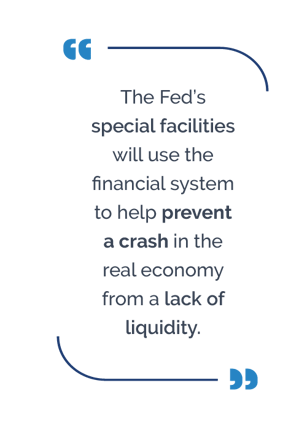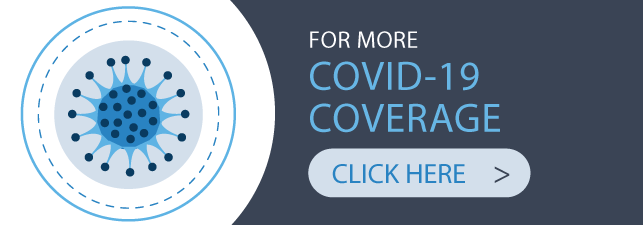What's new
The Federal Reserve (Fed) has taken another step in its attempt to avert a financial crisis. It revived its Term Asset-Backed Securities Loan Facility (TALF), a measure last used in the Great Recession. The TALF will enable the issuance of asset-backed securities (ABS) backed by student loans, auto loans, credit card loans, loans guaranteed by the Small Business Administration (SBA), and certain other assets. It will do so by lending to those holding AAA-rated ABS.
As I noted in an earlier blog post (Fed to the Rescue: Providing Liquidity to Corporate Bond Market), the Fed’s objective with recent facilities is to support company borrowing and functioning. With a large-scale shutdown of activity and the resulting loss of income, businesses and households are now grappling with a lack of cash relative to their obligations. This has contributed to distressed selling in attempts to raise cash.
What's next?
I expect the Fed to take further extraordinary measures, as it did in 2007-2009.
The Fed signaled it is planning a lending measure to help small businesses: "...the Federal Reserve expects to announce soon the establishment of a Main Street Business Lending Program to support lending to eligible small- and medium-sized businesses,
 complementing efforts by the SBA." The Fed may have waited to see what would come out of Congress. The Coronavirus Aid, Relief and Economic Security (CARES) Act was signed into law on March 27, and that Act boosted the Treasury's Exchange Stabilization Fund by a huge $425 billion. That extra funding will allow the Treasury to provide equity for Fed special facilities that should offer far more lending.
complementing efforts by the SBA." The Fed may have waited to see what would come out of Congress. The Coronavirus Aid, Relief and Economic Security (CARES) Act was signed into law on March 27, and that Act boosted the Treasury's Exchange Stabilization Fund by a huge $425 billion. That extra funding will allow the Treasury to provide equity for Fed special facilities that should offer far more lending.
The shock of the pandemic hit the real economy, and the financial system is one of the victims. The Fed’s special facilities will use the financial system to help prevent a crash in the real economy from a lack of liquidity.
Most of any future measures would likely involve section 13(3) authority and would need the approval of the Treasury Secretary.
I continue to believe the Fed will revive its Term Auction Facility (TAF) originally created in 2007. Banks bid for funds from the Fed anonymously—accessing liquidity without stigma. I am surprised the Fed hasn't revived this facility yet.
TALF details:1
The TALF will serve as a funding backstop for ABS issued by eligible issuers.
The Federal Reserve Bank of New York will create a Special Purpose Vehicle (SPV) on a recourse basis and lend to the SPV the funds that it needs.
The New York Fed will be secured by all the assets of the SPV.
The Department of the Treasury, using the Exchange Stabilization Fund, will make an initial $10 billion equity investment in the SPV in connection with the facility. The Fed is not allowed to take credit risks, which are a fiscal action. The Treasury will help provide a backstop and absorb any losses.
The SPV initially will make up to $100 billion of loans available. The loans will have a term of three years, will be nonrecourse to the borrower, and will be fully secured by eligible ABS.
All US companies that own eligible collateral and maintain an account relationship with a primary dealer are eligible to borrow under the TALF. A US company includes entities that have a non-US parent company or a US branch or agency of a foreign bank.
Eligible collateral includes US-dollar-denominated cash (that is, not synthetic) ABS that have a credit rating in the highest long-term or the highest short-term investment grade rating category from at least two eligible nationally-recognized statistical rating organizations (“NRSROs”) and do not have a credit rating below the highest investment grade rating category from an eligible NRSRO.
Eligible ABS must be issued on or after March 23, 2020.
Eligible collateral must be ABS where the underlying credit exposures are one of the following:
- Auto loans and leases;
- Student loans;
- Credit card receivables (both consumer and corporate);
- Equipment loans;
- Floor plan loans;
- Insurance premium finance loans;
- Certain small business loans that are guaranteed by the SBA; or
- Eligible servicing advance receivables.
To be eligible collateral, all or substantially all of the underlying credit exposures must be newly issued.
The feasibility of adding other asset classes to the facility will be considered in the future.
The pledged eligible collateral will be valued and assigned a haircut.
For eligible ABS with underlying credit exposures that do not have a government guarantee, the interest rate will be 100 basis points over the two-year LIBOR swap rate for securities with a weighted average life less than two years, or 100 basis points over the three-year LIBOR swap rate for securities with a weighted average life of two years or greater.
The SPV will assess an administrative fee equal to 10 basis points of the loan amount on the settlement date for collateral.
Loans made under the TALF will be pre-payable in whole or in part at the option of the borrower, but substitution of collateral during the term of the loan generally will not be allowed.
1federalreserve.gov/monetarypolicy/talf.htm as of April 2, 2020.
The information is based on limited information about TALF 2.0 and is therefore incomplete and subject to revision or clarification. There is no guarantee that the experience with TALF 2.0 will be similar to TALF 1.0 and it could be very different. We make no representation or warranty with respect to the accuracy or completeness of this material, nor are we obligated to provide updated information on the securities/instruments mentioned herein. All investments carry the possibility of loss as well as profit.
MALR025211
Market conditions are extremely fluid and change frequently.
This blog post is provided for informational purposes only and should not be construed as investment advice. Any opinions or forecasts contained herein reflect the
subjective judgments and assumptions of the authors only and do not necessarily reflect the views of Loomis, Sayles & Company, L.P. Information, including
that obtained from outside sources, is believed to be correct, but Loomis Sayles cannot guarantee its accuracy. This material cannot be copied, reproduced or
redistributed without authorization. This information is subject to change at any time without notice.





